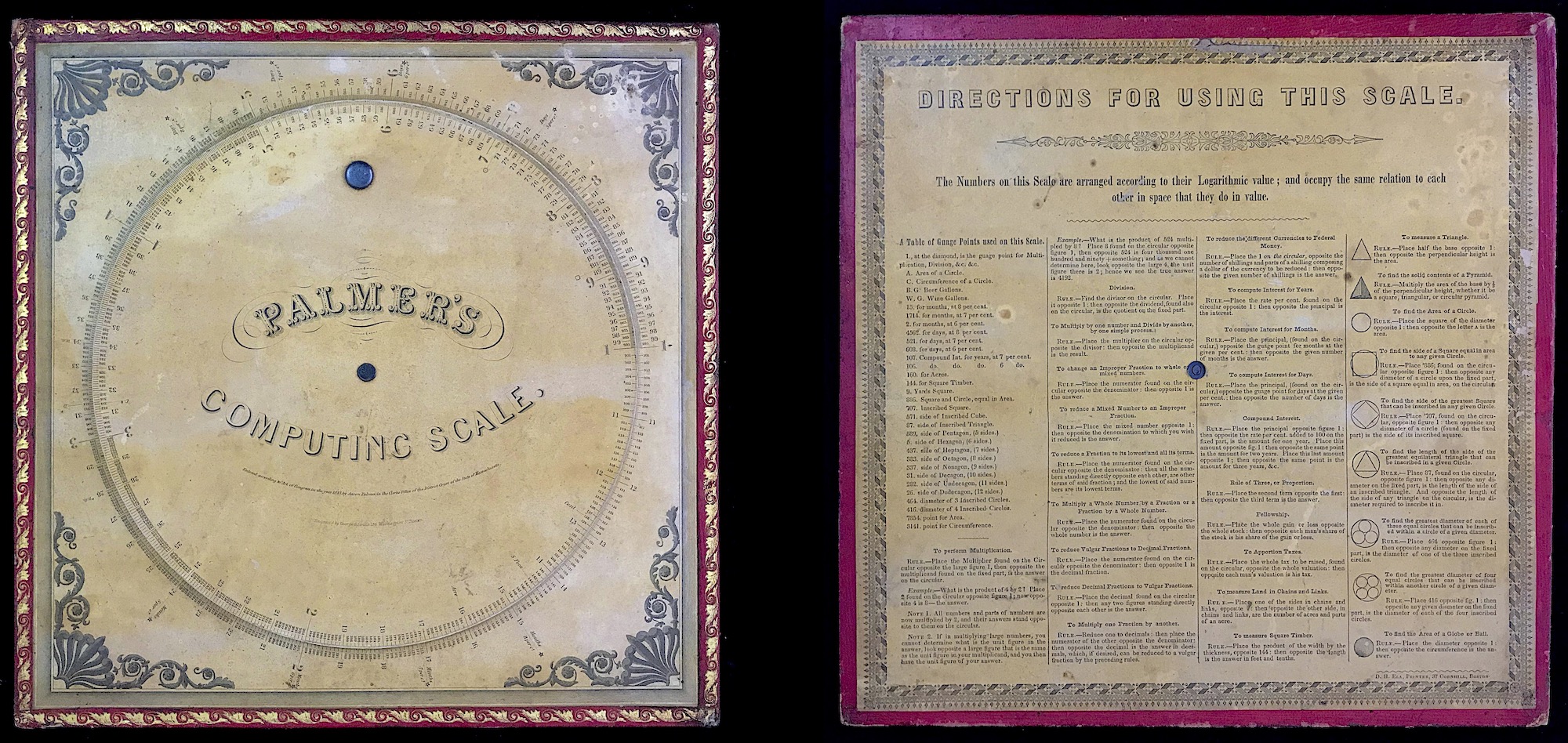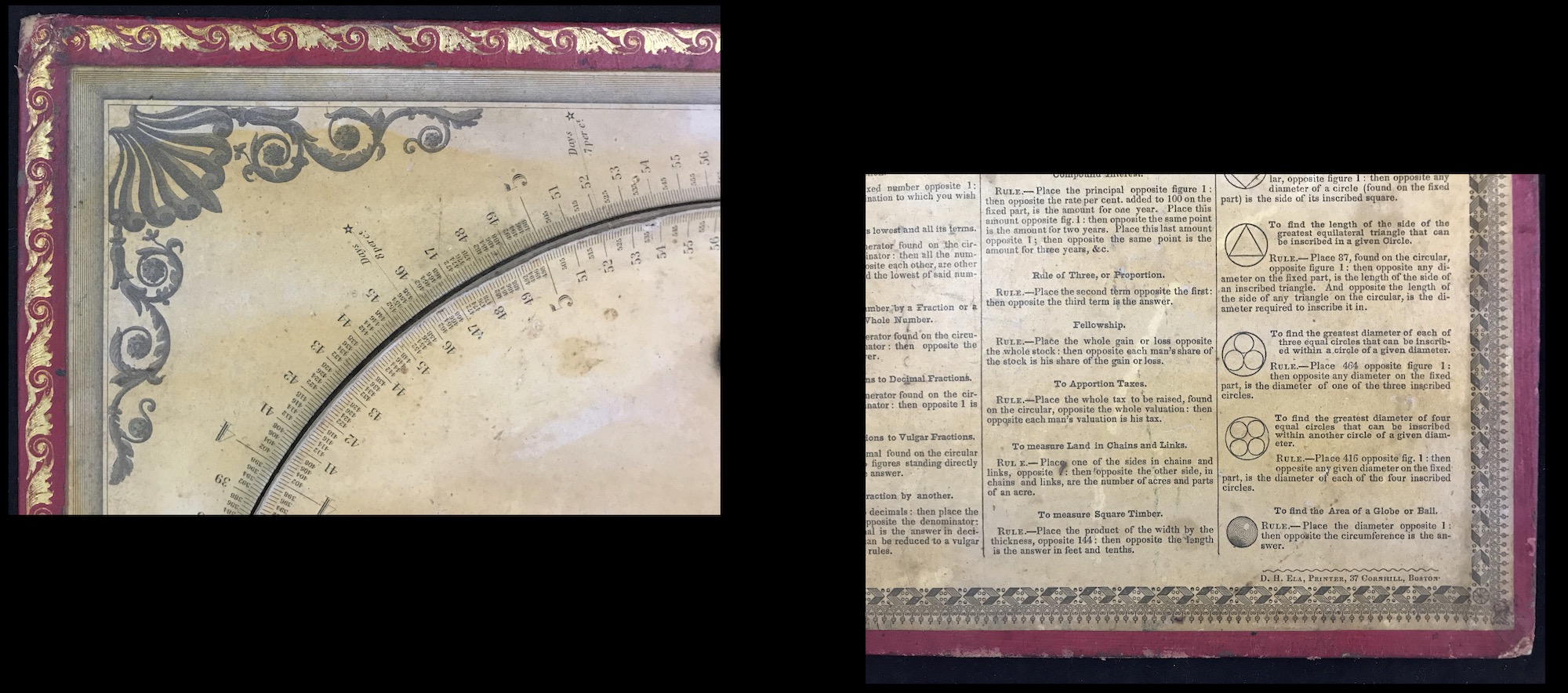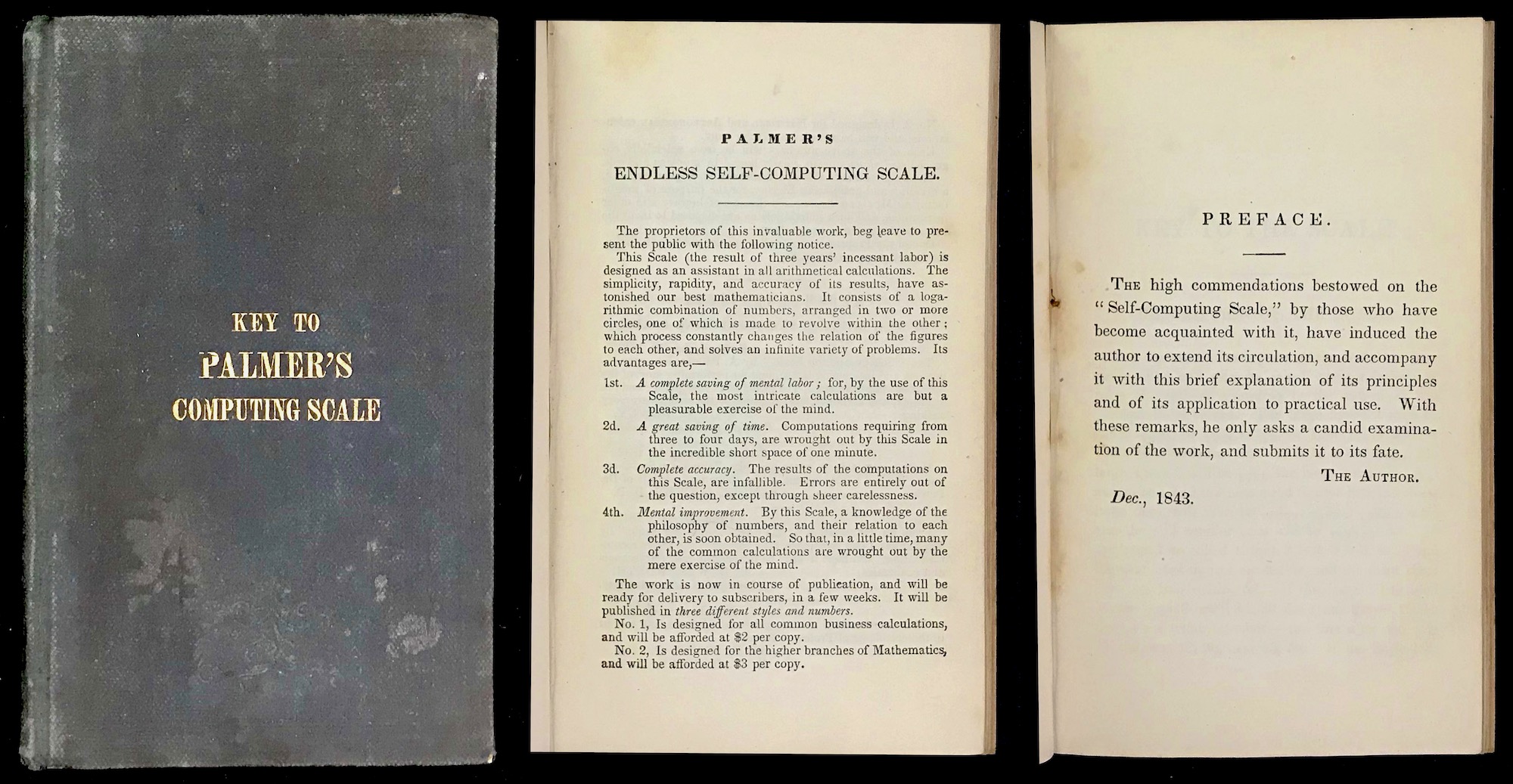8.21 America’s Earliest Slide Rule
Originally posted: 2023 Mar 10
Prior to about 1895, slide rules were imported to America from Europe. Until that time, only Germany, France, and the United Kingdom manufactured slide rules, which were exported around the world. It wasn’t until the mid-1890s that Keuffel and Esser began to manufacture their own slide rules in the United States. According to records,74 K&E began curing their own mahogany wood for use in making slide rules in 1891, which they claimed was a 5-year process, and so their first self-produced rules on the market – basic linear Mannheim-style slide rules – showed up after about 1895.
However, there had been an earlier slide rule that was designed, constructed, and sold in the United States many years earlier. According to the 1909 book by Cajori75, Aaron Palmer’s Computing Scale was introduced in the U.S. in 1844 in Boston, Massachusetts. The Computing Scale was a circular slide rule with two opposing logarithmic scales and, with a diameter of 8 inches, it could perform calculations with 3-4 digit accuracy with ease. The slide rule was made of paper scales laminated to heavy cardboard76, with an overall 11 inch by 11 inch square shape. The back side of the Scale had tables of Gauge Marks and instructions for its use in everyday problems. A separate article written by Cajori in 1909 starts out by stating,77
“Palmer’s instrument is of special interest to Americans, because it is one of the first, if not the first, slide rule that was designed, manufactured, and sold in the United States.”

He goes on to explain how prior to around 1842,
“… we are safe in concluding that among us such an instrument as the slide rule was known to exist, but probably very few people in this country had ever seen one, or learned how to use it. […] considerable interest attaches to the work of Aaron Palmer, who entered upon a line of study that was new in America and designed the slide rule which bears his name.”
Cajori wrote those words already 117 years ago, and since then further evidence was uncovered about the development of this slide rule. There are accounts of a prototype version of the scale being demonstrated by Palmer in the Buffalo/Rochester, New York, area in early 1842.78 Palmer then had the Scale copyrighted as “Palmer’s Computing Scale” in Boston in late 1843, with the first commercial appearance (Issue One) of the rule around January 1844. Six weeks later, in mid-February, 1844, Palmer wrote that he had made corrections to the rule and the subsequent versions had a slightly different set of Gauge Marks and instructions on the back. This would be Issue Two.
From the Cajori and Feazel references, the Palmer’s Computing Scale in the Collection, shown above, is a rare Issue One. I received this scale from a dealer who discovered it on the top shelf in a bedroom closet at an estate sale in Skowhegan, Maine, in 2022. It has 32 gauge marks listed on the back, as well as “D.H. Ela, Printer, 37 Cornhill, Boston” in the bottom right corner. On the front is “Engraved by George G. Smith 186 Washington St. Boston”, which is missing on Issue Two.


Around the same time that this Issue One was being produced, Palmer also obtained copyright for his “Key to the Endless Self-Computing Scale” in December of 1843, which was published in early 1844. (An 1842 version of the publication was also printed, while peddling his new scale.79) This small 4-in \(\times\) 7-in, 50-page hardbound book contains the same information as on the back of the Issue One scale, but offers a few additional examples and tables of information. The example of the “Key” shown in the figure below was received from a book dealer in San Diego, California in 2023. In this book Palmer notes that three versions of the Scale are to be sold, one for “all common business calculations”, one for “the higher branches of Mathematics”, and one for “NAUTICAL and ASTRONOMICAL calculations”; however, I have not found any evidence of any breakdown into various models being brought to market. He also tells the reader he is constructing “at great expense” a dividing and graduating engine, in order to manufacture “METALLIC SCALES”. An example of a brass Pocket Scale was documented in Feazel’s second article,80 but metallic rules did not appear to proliferate.

But then in early 1844, as Issue Two was coming out, a new revised 48-page instruction booklet became available entitled, “Palmer’s Pocket Scale”. This new manual was essentially the same as the “Key”, but included a 2.5-inch diameter pocket version of the Computing Scale attached to the inside back cover. (It no longer mentions other special editions nor metallic scales.) The Pocket Scale booklet shown in the figure below, from 1845, was obtained from a bookseller in Michigan in 2023. Similar to the “Key”, the Pocket Scale booklet contains the contents from the back of the original Issue One scale but, as the author explains, “… All errors, which have been discovered in the former editions, have been corrected in this, and the present work may be regarded as nearly perfect.” From the timing of the first publication of the Pocket Scale, it is evident that the “Key” and Issue One of the Computing Scale were produced during a very short few-weeks period between December 1843 and February 1844. One may wonder why a second edition of the instruction booklet would come out just a few weeks after the first. I believe that Palmer’s new additional sentences to his Preface to the book answer this question:
… The present volume can be afforded at a price which will place it within the reach of all. Those who wish to carry out their computations to a greater number of decimals, can have their wishes gratified in the purchase of “Palmer’s Computing Scale,” which is nearly one foot square. …

The Computing Scale was on display at the the Eighteenth Fair at the American Institute in New York City, in the Fall of 1845.81 But sometime in the period of 1844-1845 John Fuller from England became involved with Palmer in the further development of the slide rule. This was also the year in which Fuller copyrighted his “Time Telegraph” set of non-logarithmic scales. According to Feazel, the Time Telegraph scales, which compute the number of days between any two given dates, began to replace the back-side instructions on Palmer’s scale, and a set of instructions came separately with the new devices. The new instrument – Issue Three – had the words “Palmer’s Computing Scale, Improved by Fuller” on the front side. In fact, there is no further documented evidence of Palmer being involved with the scales after February 15, 1844. Feazel was able to trace Fuller and his promotion of the new scale set in Europe through the year 1871. Overall, he notes, there are at least seven issues of the Palmer’s Computing Scale – including the prototype version – and at least five distinct versions of an instruction book, as of the writing of his article in 1995. The third issue of the instruction book, now titled “Improvement to Palmer’s Endless Self-Computing Scale and Key” and published in New York in 1846, has the words “Key to Fuller’s Computing Telegraph” on the front cover.82
Also, according to Feazel, the last known instruction book written in 1871, and found in London, is titled “The Computer”, and the slide rule is referenced within the manual as the computer. It is perhaps one of the earliest references to a computational device as a “computer”. Prior to this time, a computer was a person that performed computations! This new use of the word did not seem to stick, however, and did not re-surface until the 1950s and 60s with the invention of the “electronic computer” (which would presumably replace human computers), simply referred to as a “computer” today.83
It is very interesting to note that the development of the first Palmer’s Scale was taking place at almost the exact same time as Lieutenant Amédée Mannheim was introducing his new linear slide rule scale arrangement in France. The Mannheim style of linear slide rule with its cursor for reading results became a standard for the next 100 years. Circular slide rules did not re-surface with any significant market share in the U.S. for another 70 years or so. It is not known exactly why the Palmer scale did not have the success that was clearly seen with the linear slide rules. Perhaps it was its size, or its paper construction. From Feazel,84
[Feazel] In late 1847 Mr. Fuller gives us some insight into the possibility that the Computing Scale may have become a toy and not taken seriously:
“… a large proportion are using it becaues it combines entertainment with discipline. …many persons have purchased it … to amuse them, and to furnish a perfect check upon questions solved by any other process.”
Though perhaps not as rare as the first prototype, it is wonderful to have found a “first edition” of one of the earliest slide rules to be made in the United States roughly 182 years ago.
Be sure to read the vignette America’s Earliest Part II for an update on this subject.
See, for example, https://www.mccoys-kecatalogs.com/KECatalogs/100thAna/100thAna.htm, p11.↩︎
Florian Cajori, A History of the Logarithmic Slide Rule and Allied Instruments, The Engineering News Publishing Company, New York, 1909.↩︎
Bobby Feazel, “Palmer’s Computing Scale”, JOS 3.1 p9 (1994).↩︎
Florian Cajori, Aaron Palmer’s Computing Scale, Colorado College, Colorado Springs, June 1909.↩︎
Ibid.↩︎
Peggy Aldrich-Kidwell, “Useful Instruction for Practical People: Early Printed Discussions of the Slide Rule in the US”, IEEE Ann. Hist. Comput., 37 1 p43 (footnote 35).) ↩︎
Bobby Feazel, “Palmer’s Computing Scale – Revisited”, JOS 4.1 p5 (1995).↩︎
See the mention on page 3 of Scientific American, Vol. 1, Issue 8, October 16, 1845.↩︎
Feazel, 1995.↩︎
Other references are said to exist of similar objects being called a “computor” and sometimes “computer” by this time in history (1870s), and perhaps a bit earlier. But still, the use of the word in this context appeared to go dormant for many decades.↩︎
Ibid.↩︎